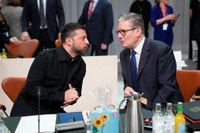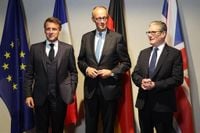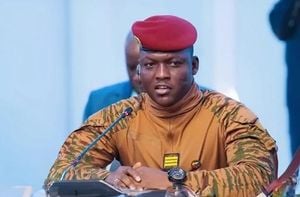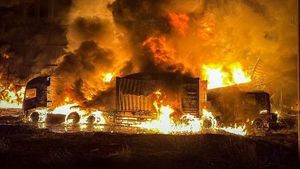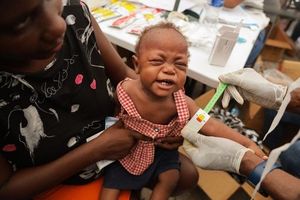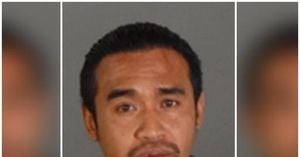In a significant escalation of Western support for Ukraine, the leaders of the United Kingdom, Germany, and France have jointly announced their readiness to use the value of frozen Russian state assets to bolster Ukraine’s armed forces. This coordinated move, declared in a series of statements and phone calls on October 10 and 11, 2025, marks a new phase in the ongoing effort to pressure Moscow as the war in Ukraine grinds on with no end in sight.
According to Reuters and the BBC, UK Prime Minister Keir Starmer, French President Emmanuel Macron, and German Chancellor Friedrich Merz agreed during a recent conversation to “progress towards using, in a coordinated way, the value of the immobilised Russian sovereign assets to support Ukraine’s armed forces and thus bring Russia to the negotiation table.” The leaders emphasized that this initiative would be undertaken in close cooperation with the United States, underscoring the unity among Kyiv’s Western allies.
The push comes at a critical time for Ukraine. Kyiv faces a daunting $65 billion external budget gap for the years 2026–2029, even as war-related costs continue to mount. Since the outbreak of Russia’s full-scale invasion in 2022, Western governments and partners have immobilized approximately $300 billion in Russian central bank assets, with roughly two-thirds of these funds held in Europe. Until recently, only profits and interest accrued from these assets had been used to support Ukraine; now, the leaders are signaling readiness to tap into the principal value itself.
In a statement released by the British government and cited by The Kyiv Independent, the three European powers agreed to "develop further bold and innovative mechanisms to increase the cost of Russia's war and ramp up pressure." This will include additional steps against Russia’s so-called “shadow fleet”—a group of aging oil tankers Moscow uses to evade international sanctions and conduct subversive activities.
The leaders’ unified stance was echoed in remarks from Prime Minister Starmer, who told Ukrainian President Volodymyr Zelensky that the UK, France, and Germany were "united in wanting to drive progress towards using the full value of the immobilised Russian sovereign assets to end the war." Starmer also announced that "more sanctions in the coming days and weeks" would further increase the pressure on Moscow.
The timing of these announcements is no coincidence. On October 10, Russia launched extensive missile and drone strikes across Ukraine, causing widespread power outages in Kyiv and eight other regions. Ukrainian officials reported that two people were killed and at least 20 injured in the attacks, which targeted civilian and energy infrastructure. President Zelensky condemned the strikes as a "cynical and calculated attack," and called for "decisive action—not empty words—from the United States, Europe, and the G7 in delivering air defence systems and enforcing sanctions." He stressed, "Every sanction decision weakens Russia's war machine."
European leaders had already met in Copenhagen the previous week to discuss the possibility of using frozen Russian assets as collateral for a €140 billion ($162 billion; £121 billion) loan to Ukraine. The idea, which has gained traction in both the EU and G7, is that Ukraine would begin repaying the loan only after Russia ends the war and pays post-war reparations. The value of frozen Russian assets in the EU alone is estimated at nearly €211 billion (£181 billion), according to BBC reports.
German Chancellor Friedrich Merz, quoted by Reuters, said he expects a decision on the use of frozen Russian assets for further aid to Ukraine within October 2025. The leaders’ joint statement made clear that they are "ready to move forward in the direction of coordinated use of frozen Russian sovereign assets to support the Armed Forces of Ukraine and, thus, bring Russia to the negotiating table."
Meanwhile, Ukraine is already receiving some support from these immobilized assets through the G7’s $50 billion Extraordinary Revenue Acceleration (ERA) loan. However, as the financial needs of Kyiv grow, Western officials are exploring new mechanisms. The EU’s proposal for a reparations loan would provide Ukraine with at least €140 billion ($160 billion), to be repaid only once Moscow agrees to pay war reparations—a move designed to both sustain Ukraine and maintain legal and financial responsibility.
According to Interfax-Ukraine, the leaders also condemned Russia’s repeated attacks on Ukraine’s critical national infrastructure, which is essential for providing light and warmth to the population—especially as winter approaches. The UK, Germany, and France have reiterated their steadfast support for Ukraine, including through the so-called "Coalition of the Willing."
Importantly, the leaders underscored their commitment to act in close coordination with the United States and the European Union. They discussed the need for interregional coordination on the peace process and commitments to a ceasefire in regions where possible. The leaders also reaffirmed their support for Ukraine’s peace plan and the next stages of negotiation.
While the idea of using frozen Russian assets is not without controversy, Western leaders have stressed the importance of adhering to international obligations and financial responsibility. As noted in the joint statements, a significant portion of these assets is concentrated in the EU, and participating countries have expressed some caution regarding their further use to finance Ukrainian support. Nonetheless, the determination to "develop bold and innovative mechanisms" remains strong.
The joint declaration also targets Russia’s "shadow fleet," with plans to ramp up action against this network of tankers that has helped Moscow sidestep shipping and energy sanctions. By tightening restrictions and enforcement, Western powers hope to further limit Russia’s capacity to finance its war effort through covert oil exports.
The diplomatic maneuvering has not gone unnoticed in Moscow. Russian officials have repeatedly denounced Western moves to seize or reallocate their assets as illegal. Yet, as the war drags on and Ukrainian cities endure fresh bombardments, Western governments appear increasingly willing to push the boundaries of economic warfare to support Kyiv.
On the ground, the stakes remain high. President Zelensky has continued to urge Western leaders to deliver not just financial support, but also critical military aid such as air defense systems. He has called for the UK to join the PURL programme, under which NATO countries buy weapons from the US to send to Ukraine, and has pressed for even tougher sanctions on Russia.
As the leaders of the UK, France, and Germany press forward with their plan, the world will be watching closely to see whether this unprecedented use of frozen Russian assets can help tip the balance in Ukraine’s favor—or at least bring Moscow back to the negotiating table. The coming weeks are likely to be decisive, as Western capitals weigh both the risks and the necessity of bold action in the face of ongoing aggression.
With a united front and a willingness to innovate, Europe’s leading powers are signaling that they are not backing down—and that, for Ukraine, crucial support may soon be on the way.
